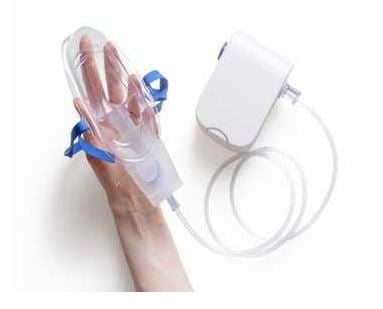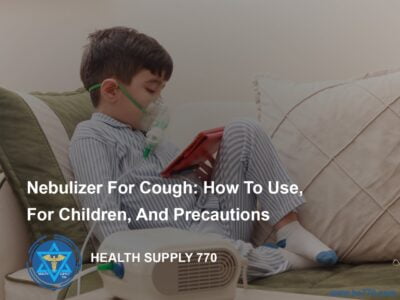Inhalation of pharmaceutical drugs in case of respiratory disorders is an effective way to maximize efficacy as well as to reduce the side effects of the medications. This allows the penetration of drug particles deeper into the lower respiratory tract thus facilitating higher drug concentration at the target site consequently boosting the therapy. To achieve this purpose, nebulizer machines are being employed.
A nebulizer for cough is a device that is used to assist respiration in a patient experiencing a cough along with additional breathing difficulties due to asthma or other respiratory illnesses. Pharmaceutical drug solutions are administered directly to the lungs via nebulizing equipment as they get transformed into a continuous fine aerosol mist during the process making it easy to take them in. Although it is a short-term treatment, it can significantly help eliminate cough, shortness of breath, wheezing, and chest tightness by reducing inflammation of the respiratory mucosa due to the effective delivery of drug-loaded atomized particles to the affected areas.

A portable nebulizer with tubing and a mask
When a nebulizer is needed?
Nebulizer treatments may be recommended to children as well as older individuals in case of:
• Asthma
• Bronciectasis (widened airways of the lungs)
• Cystic fibrosis (a genetic condition that damages the lung tissue)
• Chronic obstructive pulmonary disease (COPD) (a group of diseases causing blockage of the airways)
• Sinusitis (swollen sinuses)
• Exposure to smoke
• Pneumonia
• Acid reflux
• Allergies
This role of a nebulizer in treating respiratory conditions is particularly helpful for those who cannot use inhalers such as bedridden elderly patients, babies, etc.
Types of nebulizers
There are three types of nebulizers which are available in the market:
- Ultrasonic nebulizers: These nebulizers use high-frequency vibrations to make an aerosol, the tiny particles of the liquid drug ejected in the form of a mist.
- Jet nebulizers: In this type of nebulizer, compressed gas is employed to prepare the aerosol.
- Mesh nebulizers: In mesh nebulizers, the mist is prepared by passing the liquid medication from a fine mesh.
The mist nebulizer formed by the mesh nebulizer is the finest in terms of particle size as compared to that formed by the other two which elevates the effectiveness as well as the cost of this instrument.
Though all the above-mentioned three types are safe to use in children as well as in elders.
Parts of a nebulizer
A nebulizing machine consists of 4 main parts:
• A base that carries the air compressor
• A tube that connects the machine with the spacer
• A medicine cup or chamber with a dome-shaped cap to hold the liquid medication
• A mouthpiece or mask to be put into the patient’s mouth to breathe in

A nebulizer machine
How to use a nebulizer for cough?
• Make sure to wash your hands properly prior to using a nebulizer.
• Add the medications prescribed by your physician into the medicine cup.
• Assemble the tubing, mouth piece and mask.
• Turn on the nebulizer. Make sure that the vapors of the added medication are visible in the spacer. If not, a readjustment of the assembly or proper placement of the drug might be necessary.
• Hold the medicine cup in an upright position so that the mouth piece is straight.
• Ask the patient to slowly breathe into the mouth piece to ensure the effective transfer of medication to the lungs.
• If the patient feels dizziness while inhaling the medication, stop the process for 5 min. When the patient feels better, nebulization can be resumed. If the symptoms still last, it is advised to contact your healthcare provider.
• A 10 to 20 min use of nebulizer treatment is usually enough for a single cycle but it can be used until all the medication has been inhaled. However, the patient may need to get nebulized multiple times a day depending upon the condition.
• Wash your face after the process is completed to eliminate the possible traces of the drug. In case of steroid or ipratropium bromide administration, it must be ensured that the mouth piece is fitted well onto the mouth as the drugs may cause glaucoma or cataract.
• Turn the machine off when the medication finishes. Wash the mouth piece and medicine cup and air dry them for future use.
Drugs administered using a nebulizer
A nebulizer is a breathing machine that is efficacious to deliver multiple drugs into the respiratory tract with minimum wastage. These drugs include:
Antibiotics:
Nebulizers can be used to administer antibiotics to treat bronchial infections. As taking oral medication does not ensure the complete transfer of the drugs to the lungs, the use of a nebulizer may reduce drug wastage. Tobramycin, azithromycin, and levofloxacin are some of the commonly administered drugs via nebulizers.
Bronchodilators:
Bronchodilators, as the name suggests, are drugs that dilate the air passageway making more room for the air to penetrate into the lungs. These are the immediate treatment in case of constricted bronchi with difficulty in breathing. Commonly used bronchodilators are albuterol, formoterol, salmeterol, levalbuterol, and salbutamol among others.
Corticosteroids:
Corticosteroids such as flunisolide, fluticasone, triamcinolone, and budesonide can also be administered using a nebulizer for cough to ease the breathing process by reducing inflammation.
Saline solution:
Sterile saline solutions can also be administered to the lungs to clear up the mucus filled in the bronchi by decreasing its consistency and expanding the lumen to facilitate the influx of oxygen.
Side effects of using a nebulizer for cough
The use of a nebulizer for cough relief, along with other indications, is quite safe but in some, particularly in children, it can cause:
• Nasal irritation
• Cough
• Sneezing
• Stuffy nose
• Wheezing
Precautions
• Although a nebulizer is a safe medical device with almost no side effects, proper care should be taken to clean it thoroughly after every use as the remains of any medication within the medicine cup, tubing, mask and the spacer may provide an ideal environment for the growth of mold as well as bacteria.
• Use of soap with sterile water or rubbing alcohol is recommended for this purpose. It can also be placed in the dishwasher followed by air drying on a towel.
• It is also advised to disinfect the machine using vinegar or any other disinfecting solution as per instructed by the manufacturer.
• Replacement of some parts of the nebulizer every three months is also important to avoid contracting infections from the previously used segments. Store the nebulizer at a place away from dust, smoke or other particulate matter.
Disinfecting a nebulizer
To disinfect a nebulizer, one part of white vinegar (half a cup) is mixed with three parts of water (one and a half cup). This will give you a disinfecting solution. Pour it into a wide-mouthed container and soak your equipment into it for 15 to 20 min. After this, take the parts out and thoroughly wash them with water. Place these on a paper towel until air dry. It is advised to use a zipper plastic bag to store these parts in a cool and dry place.
Conclusion
Nebulizers are easy-to-use, economical, and efficient machines used for the effective transfer of medications into the lower respiratory tract. To get a nebulizer treatment, there is no requirement for any assistance from a medical practitioner or a nurse as it is uncomplicated to operate it. All of these properties make nebulizers one of the best medical devices in use today.

PhD Scholar (Pharmaceutics), MPhil (Pharmaceutics), Pharm D, B. Sc.
Uzma Zafar is a dedicated and highly motivated pharmaceutical professional currently pursuing her PhD in Pharmaceutics at the Punjab University College of Pharmacy, University of the Punjab. With a comprehensive academic and research background, Uzma has consistently excelled in her studies, securing first division throughout her educational journey.
Uzma’s passion for the pharmaceutical field is evident from her active engagement during her Doctor of Pharmacy (Pharm.D) program, where she not only mastered industrial techniques and clinical case studies but also delved into marketing strategies and management skills.
Throughout her career, Uzma has actively contributed to the pharmaceutical sciences, with specific research on suspension formulation and Hepatitis C risk factors and side effects. Additionally, Uzma has lent her expertise to review and fact-check articles for the Health Supply 770 blog, ensuring the accuracy and reliability of the information presented.
As she continues her PhD, expected to complete in 2025, Uzma is eager to contribute further to the field by combining her deep knowledge of pharmaceutics with real-world applications to meet global professional standards and challenges.








